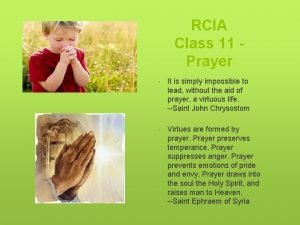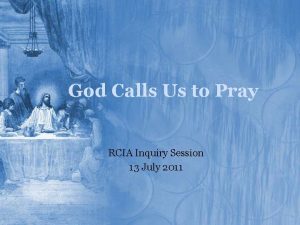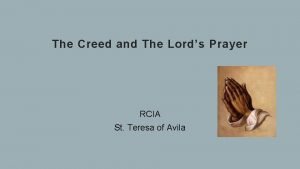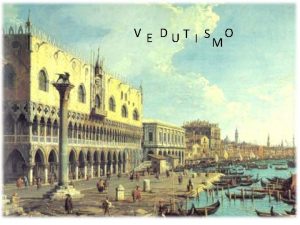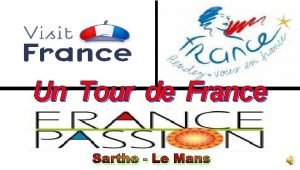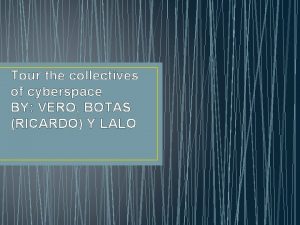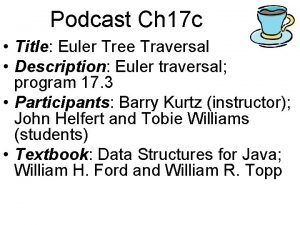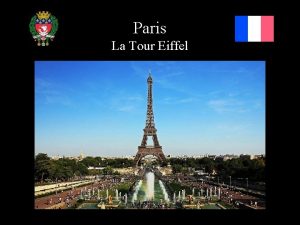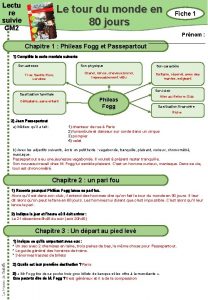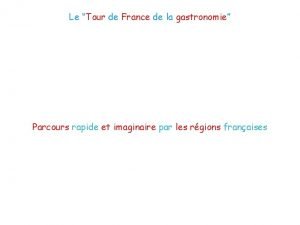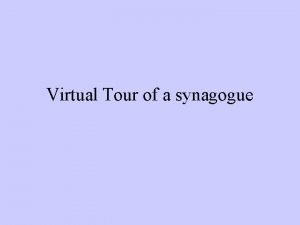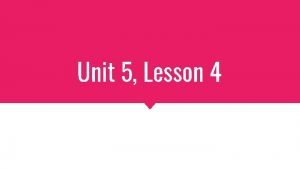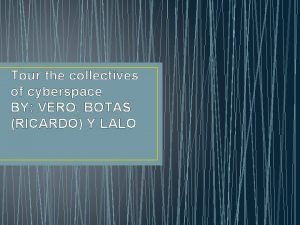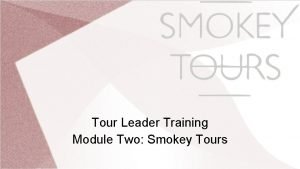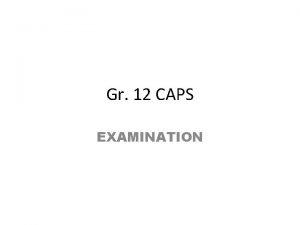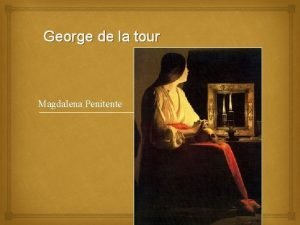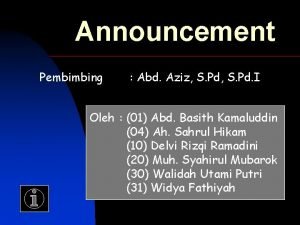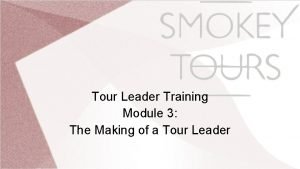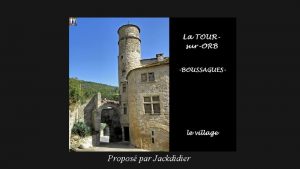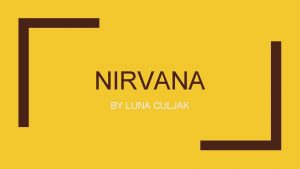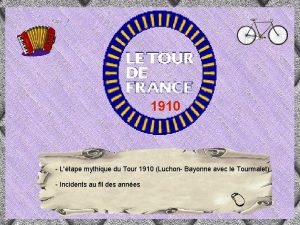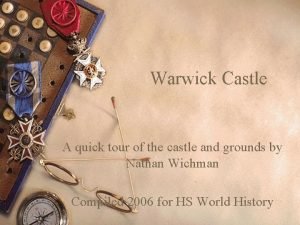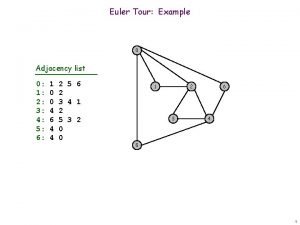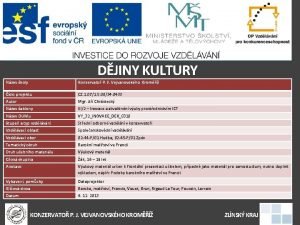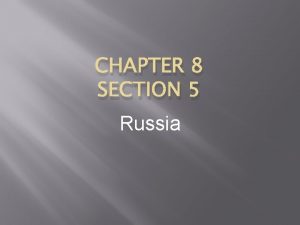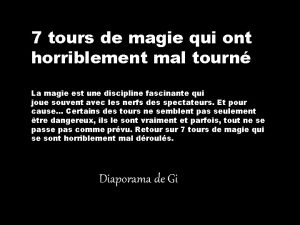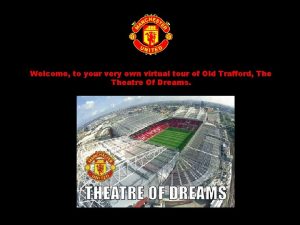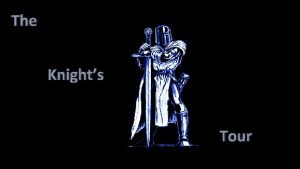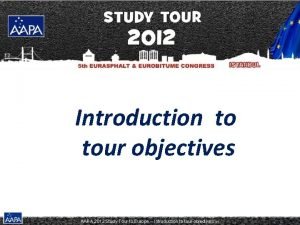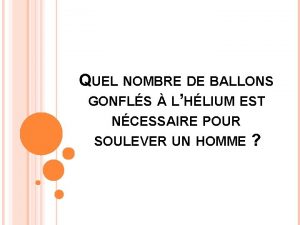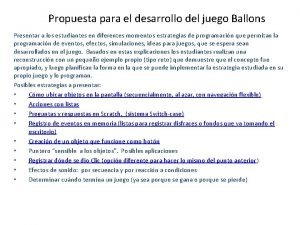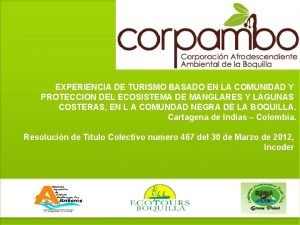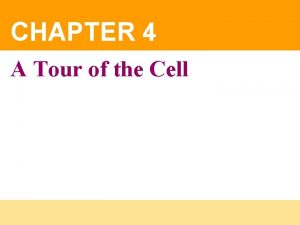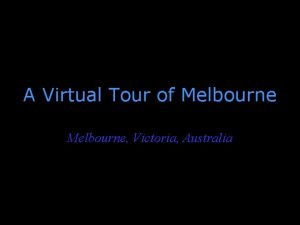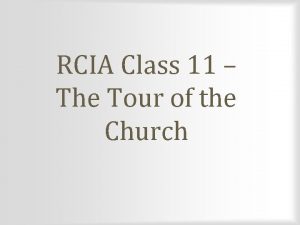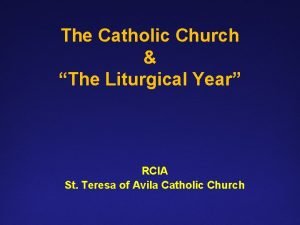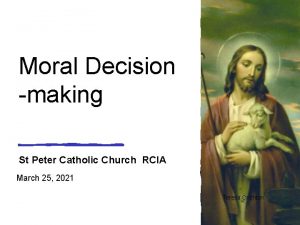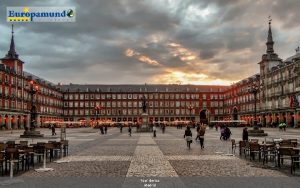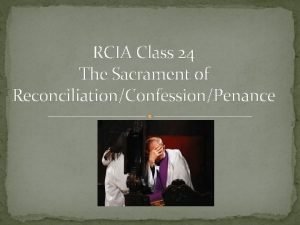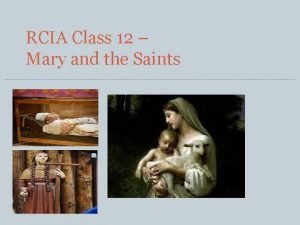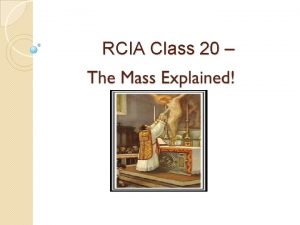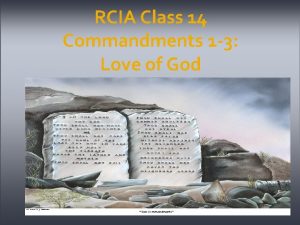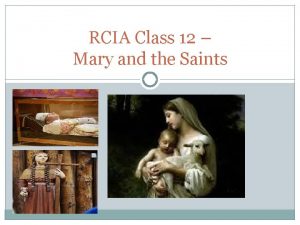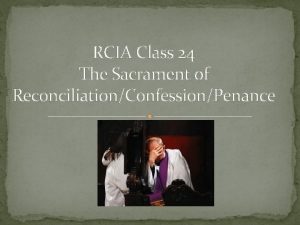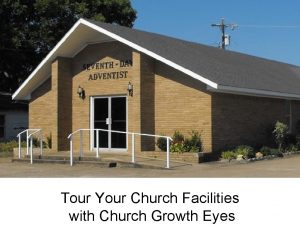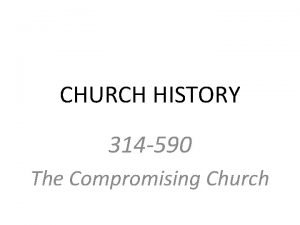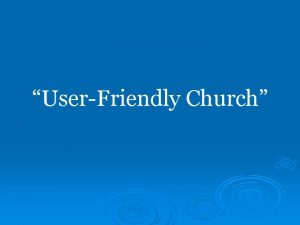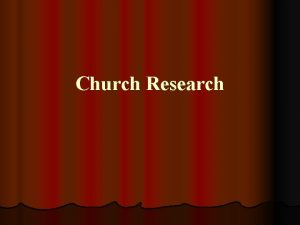RCIA Class 11 The Tour of the Church































































































































- Slides: 127

RCIA Class 11 – The Tour of the Church

Today’s topics! • The Tour of the Church. • First, we will start talking about church architecture, • Then we’ll move upstairs into the church after break and talk about the different things that we see at church, • Altar • Candles • Books • Incense • Vestments • Sacred vessels • And the various things we use in the church throughout the year and why we use them.

What is the Church? The word Church Comes from a Greek word “ekklesia. ”’ Comes from a Latin word, “ecclesia, ” These words mean “those that are called together, ” “those that are assembled together. ”

st 1 When were the Churches established? • If we were to open our Bibles to the Acts of the Apostles, we would see that the apostles traveled from church to church shortly after the time of Jesus’ death, resurrection, and ascension. • The church building as we know it today – probably came in the first couple of hundred years. • As we discussed in a few classes earlier, the Christians in the early church were persecuted and Christianity was not legalized until the year 315 under Constantine.

What about the first churches? • The first churches were built in the early days of Christianity, probably in the first couple of hundred years. • There was persecution of the Christian Church under the emperors, such as Nero, Decius, and Diocletian. • The first churches began to be built under Constantine about the year 315. • Before that, the people were meeting in peoples’ homes for services. • In the first 300 years, they were also meeting in the catacombs, the underground tunnels underneath the city of Rome. • Churches eventually began to be built. Most of them were in the center of towns

Then and Now • If you go to Europe today, and you want to find where the church is, just go to city center. • Usually they have steeples or bell towers, because in those days, that was the easiest way for people to see the churches at a distance. • Back then the Church was the very center of a person’s whole life. • Nowadays, in America, the shopping mall might be the center, or some other place; • In the early years, everything was centered around the cathedral, or the basilica, or the churches in Europe. • That was always the largest building in town.

The Cruciform • The shape of most of the ancient churches was in the “cruciform” shape, or the shape of the Cross. • What’s interesting about the cruciform shape is that it actually reminds us of the Body of Christ. • Some Churches today are built in this traditional way

Cruciform Architecture!

What do we see in churches? • In the Cruciform Churches design what you would find is the tabernacle would be at the center. • The tabernacle is the most important thing you’ll see in a Catholic Church. • Even the Jews in the Old Testament had the tabernacle, or a tent, a dwelling place. • The tabernacles were set up by the People of God as they traveled throughout the desert. • They said that God dwelt in a special way in His tabernacles. • The tabernacles would be like little meeting tents, and that’s where they would have worship of God.

Tabernacle – the home of Jesus Today we call our central focus, the tabernacle, usually referred to as the gold box at the center behind the altar, You’ll see this in every Catholic Church, usually they’re right in the center of the church. Some places will put them on the side, but usually they’re in the center. Before we leave today, we’ll have all of us go up and get a sneak peak tour of the tabernacle. The tabernacle is where the Lord is present, Our Lord Jesus Christ in the Holy Eucharist. You can always tell that the Lord is present, because there will be a candle lit. It’s called the sanctuary lamp.

What is the sanctuary? • The word sanctuary comes from a Latin word sanctus, meaning “holy. ” • The holiest place in the Catholic Church, or any church for that matter, would be the area called the sanctuary.

What do we find in the sanctuary? • The altar would be located in the sanctuary, • An altar is where the sacrifice is offered. • In the Catholic Church, the altar is the table on which the sacrifice of the Mass is offered. • On the altar, one or more relics of martyrs are commonly set into the altar, usually a patron saint of the church. • In the early church and in the catacombs, the altar was usually covering a tomb of a martyr. • St. Peter and St. Paul, etc.

In a church, we also find pews. . . • The pews, come from a French word meaning “benches, ” or “seats. ” • The pews are seats for worshippers in the church. • Pews are an early medieval innovation in the West, they developed from stone seats attached to walls

Kneelers… • In many churches, pews are equipped with kneelers in front of the seating bench so members of the congregation can kneel on them instead of kneeling on the floor. In a few other situations such as confessionals and areas in front of an altar, kneelers for kneeling during prayer or sacraments may also be used

Christ the Head What’s interesting is that when you look at the church, you’ll see that it really resembles a body. You have Christ, the Head, because He is in the tabernacle. The tabernacle is where we keep the Blessed Sacrament, or Holy Communion, Christ Himself. Christ is the Head of the Church, so He’s there in the very central, and the Head of the Church. Then, where we sit, and we make up the arms and the legs of the Church. We’re the Body of Christ. We sit out here in the pews. It’s the shape of a human person. The arms, and the legs, and the head - Christ being at the Head. The altar is in the sanctuary, which is the heart.

Then we have other altars… • The high altar receives its name from the fact that it is the chief altar in a church, • Because it is the main altar, it is raised on an elevated plane in the sanctuary, where it may be seen simultaneously by all the faithful in the body of the church. • The high altar symbolizes Christ, and it serves at the same time as the banquet table on which He offers Himself through the hands of the priest to the Eternal Father; for Christ is present in our churches not only in a spiritual manner but really, truly, and substantially as the victim of a sacrifice. • A sacrifice necessarily supposes a priest and an altar, and

High altar • At the center of the high altar is the tabernacle. • Most high altars are very tall, and they are made of either marble or stone

Other altars… • We also have altars here at St. Michael’s at the feet of St. Mary and St. Joseph. • Masses can be said on these altars if there is a pastoral necessity. • These altars would have been used when there were several priests living at St. Michael’s, and they would read there own Mass, if the church had many different functions happening during a given day. • Every priest is obliged to say one Mass every day whethere is a congregation present or not!

• Our church here at ST. Michael’s seats anywhere between 700 -750 people. • We have 4200 parishioners and 1800 families

The Vestibule

Next, we have a vestibule? • This is called a vestibule, or a narthex. • That’s a Greek word meaning “like an entranceway. ” • The idea of the vestibule is that you want to transition from coming from the world into the Church of God, or the House of God. • The Church is called God’s House. You want to be able to transition from the worldliness, and all your cares of the world, and all the busy activities, so you transition from the world into Sacred place. • The narthax is supposed to do that.

The Vestibule • That’s why you’d have coffee and donuts out there. You wouldn’t have coffee and donuts in the church, because this is a very holy and a very sacred place. • You could have them out in the vestibule, which is fine. That’s an area for gathering, for community, for fellowship, and for socializing. • The vestibule here at St. Michael’s has a bathroom, and provides room for book, CD, or pamphlet racks, bulletin boards • Once we leave the vestibule and enter the church, we enter the nave.

The Nave

The Nave • Once we enter into the main part of the church that is called the nave. • We get the word “navy” from that. • “Nav” is the word meaning “the ship, ” so most churches were in the shape, for example, of the ship. • In fact, the Church is always seen as the Ark of Salvation, almost like a ship upon which people go into to be saved. • Remember, at the time of Noah, when the Flood came, the people that were on the Ark were saved – those who weren’t were drowned outside. • Many of the churches have a sort of nautical feel to them, to remind us of the Ark of Salvation, wanting to be on the Ark when the Flood came, that we could be saved.

What is the nave? • The nave is the central open space in the church, often separated from the sanctuary by steps • The nave refers to the part of the church reserved for worshippers, including the central and side aisles and crossing transepts.

The transept • The transepts are the arms. • Here they represent our sacristies. • A sacristy is a room where the clergy vest and prepare for liturgical functions • The sacristy houses for sacred vessels, vestments, and other articles used for worhsip. • The transept crosses the main part of the sanctuary.

The transept • The transept is the arms of the church. • There is the altar, the Altar of Sacrifice. • That is where the Sacrifice of the Mass takes place. • As we’ll hear in a few weeks, the Mass is the same sacrifice of Jesus on the Cross. • It’s not a new sacrifice; it’s the one and only sacrifice, of Jesus offering Himself to the Father; but we are privileged that at the Mass, we are made present at the Last Supper and at Calvary. • When we attend Mass, time and space are pushed aside, and we’re present at the Last Supper and present at Calvary

The Altar • The altar is where sacrifices take place. • In the Old Testament, they had animal sacrifices. • Those are all gone, because Christ, the Lamb of God, offered Himself, and He is the One Sacrifice to the Father. He’s the Perfect Sacrifice. • All the Old Testament offerings of lamb and bullock and goat, that was only to prefigure Jesus offering Himself to the Father as the Lamb of God. • When we attend Mass, Mass is always said around an altar, because that’s where the sacrifice of Christ takes place. Jesus’ cross was like an altar, upon which He gave His life for our salvation

The Baptismal Font • You’ll always see a baptismal font in church, which is where the adults or the babies are baptized. • Often times it’s found in the narthax. • There is deep significance for that, because we became Christians through Baptism. • That’s how we first entered Christianity, was through Baptism. • Baptismal fonts are often put in the front of the Church to remind us that’s how we entered into Christianity, and this is how some of you will enter into the Church on Holy Saturday.

More on the font • For example, when you come into church, you’ll see the baptismal font right up front, and the Easter candle is always beside it. It is called the Paschal Candle. That is blessed at the Holy Saturday night mass. The baptismal font doesn’t always have to be there. It could be at other places in the church.

The Font • One reason the baptismal font is up front is because – everyone will be able to see people being baptized. • Also, we do so many baptisms at the parish (I’ve done more than 100 in my past two years here at the parish. • We usually will have, three, four, even as many as six babies being baptized every other weekend. • It’s very difficult to have six families standing back near the back of the church, with everyone trying to stand around and watch a baptism, especially for the Grandma’s and Grandpa’s. • It’s hard for them to stand for that entire length of time. By having the baptismal font in the front, you can have families sit in these pews during the baptism. Then they come up individually as a family to have the baby baptized. That’s our wisdom of having the baptismal font in the front.

Holy Water fonts • We have holy water containers at all the doors, so when people come into the doors and the different places where there are doors; you’ll see what’s called a holy water font, these small dishes. • People can dip their hand in, and you bless yourself with the holy water, and that reminds you of how you became a Christian at your Baptism. • People dip their fingers in, either one or two fingers in, and then bless yourself, in the Name of the Father, and of the Son, and of the Holy Spirit, because you were baptized in the Name of the Father, and of the Son, and of the Holy Spirit. • It serves as a reminder of your Baptism, and you’re encouraged to do that as you come in the church, and as you leave church every time.

The ceiling = vault • The ceiling is called the vault. • If you go to Europe and see some of the great cathedrals, you’ll see the magnificent ceilings or vaults that they have as well over there.

Architecture – Stained glass windows • The term stained glass can refer to colored glass as a material or to works created from it. Throughout its thousand-year history, the term has been applied almost exclusively to the windows of churches and other significant buildings. • The design of a window may be abstract or figurative; it may incorporate narratives drawn from the Bible, historical events, or it may represent saints or patrons, or use symbolic motifs. Windows within a building may be thematic, for example: within a church - episodes from the life of Christ, the mysteries of the Rosary, or other events.

Stained Glass Windows • Stained glass windows were used by some to tell a story of the life of Christ in pictures. • Some were illiterate and could not read the passage, and so by looking at the window and meditating they were able to given a glimpse of the life of the story that the window foretold

Stained Glass windows… • We will not be able to see these stained glass windows well at night, but during the day when the sun is shining they are beautiful. • Every stained glass window at our parish tells a story from the bible of the life of Christ, or the life of a saint. • Stained glass window originated during the building of the great cathedrals, because majority of people could not read during that time • The window would teach them about God, or the saint. • The windows were a way to educate the faithful who could not read.

Confessionals • Confessionals are the place where the sacrament of Penance is administered. We will walk through the confessional at the end of the tour • In the confessional, the penitent or the one who is confessing their sins, may sit face to face and tell the priests their sins asking for his God’s forgiveness or they may go behind a grille.

Stations of the Cross • In every Catholic Church, you have the Stations of the Cross. • The Stations of the Cross were invented by the Franciscans, because not everybody could get to the Holy Land, to Jersualem, to walk through the streets of Jerusalem and to make the Via Dolorosa (the way of the cross) • St. Francis and the Franciscans had an idea, they put up the 14 stations of the cross on the walls in the churches.

Stations of the Cross • This is a devotion performed by meditating on the Passion of Christ, successively before 14 stations of the Cross. • The stations are attached normally to the interior walls of a church. • The pictures depict various scenes of Christ’s journey to Calvary

What is a parish? • What does the word parish mean? ” • We have churches, but we have St. Michael’s parish. • The word parish originally comes from a word meaning “a territorial division. ” • If you go around town, you’ll see “St. Mary’s Parish, Holy Family Parish, the Newman Center Parish, and in EGF Sacred Heart Parish” • It meant a district. • But eventually, when churches were put in those places, they called each of those churches a parish. • A parish means “a territorial division. ”

Parish = territorial division • Imagine if you will 80 years ago when Grand Forks was being built. We had St. Michael’s here, and there were other parishes in town. • But if you had to go to a parish because you were living on the south side of town, it would have been a hard commute. Now, we have a lot of parishioners who come to church here because we have vehicles to get across town pretty quickly. • St. Michael’s would have served the people on the north side of town back in the day before transportation was prominent.

Other things we find in a church? • We have already discussed a tabernacle being placed in every high altar, or behind the main altar. • Beside every tabernacle, we have what we call a sanctuary lamp. • A sanctuary lamp is a wax candle, kept in a red container, that burns day and night whenever the Blessed Sacrament, or called the Holy Eucharist is reserved and present in Catholic Churches or chapels. • The lamp represents Christ’s abiding love and a reminder to the faithful to respond with loving adoration in return. • This candle is always lit to remind the people that Christ is present in the tabernacle. Is it ever not lit? ?

The answer is yes… • There are days the red candle is not lit, when? • If you ever come to church on Good Friday, the red sanctuary lamp candle will not be lit, because the Lord is removed and moved to another sanctuary for that day to remind us of his death. • Also when the church is having maintenance done, or construction done the Blessed Sacrament is removed and reverenced in another spot. • Again, the red sanctuary lamp reminds us that Christ is present, and when He is here, we genuflect and give Him reverence when we come to the House of God.

Sanctuary lamp = Christ is present • On Good Friday, the tabernacle doors remain open, and Jesus is removed, and the tabernacle lamp is extinguished. • According to Canon law, the tabernacles are always locked, and they have to be locked. • Why? • So no one can come and steal the Blessed Sacrament. • Vandalisms have occurred for centuries, especially groups that associate themselves with Satanic worship.

Where Jesus is, the lamp represents His Presence! • It is important that tabernacles are kept locked. If Jesus is not present the candle is not lit and the doors are kept wide open. • If the candle is moved a new area, like on Good Friday, a candle is lit at the new location. • Whenever Jesus is present, there is always a lit sanctuary lamp beside him.

Monstrance • On the sheet of sacred vessels that was given out to you at the beginning of class. The monstrance is a representative of a sunburst. • It is about two feet tall display receptacle that holds the Blessed Sacrament. • Here in Grand Forks, at St. Ann’s guest home chapel, Jesus is present for adoration 24 hours a day seven days a week.

What is a Monstrance? • Monstrance comes from the Latin word meaning “to show”. • During adoration, we put the host that is consecrated into a monstrance to show it, and for the purpose of prayer and adoration. • When the Lord is exposed, we usually light seven candles on each side on a candelabra , giving attention to the Lord in the Blessed Sacrament.

Ciborium • Another thing you will find in every Catholic Church is a Ciborium • A Ciborium is a gold container with a lid. • What is put into a ciborium are hosts that are either consecrated or to be consecrated at Mass. If they are consecrated, they are put into a ciborium and put into the tabernacle. • The same Lord that we receive in Holy Communion is present in every tabernacle. That is why we often use the term “Real Presence” which we will cover in a few weeks. • There is a sense that someone is there, and it is the Lord.

Vessel made for the Lord • The ciborium is a covered container used to hold the consecrated small Hosts. It is very similar to a chalice but it is covered and larger. • The ciborium is made of various precious metals, and the interior is commonly gold or gold plated.

Short little story • When Pope John Paul II came to the east coast about 12 years ago, he came to Baltimore. • The secret service had to go into the place where he was staying to make sure that there were no bombs placed. • So they sent dogs into that place and when the dogs made there way into the chapel by the tabernacle, they kept barking. • What did the dogs find? They found a person named Jesus. • The dogs recognized the Real Presence.

Church= house of God • When we open the tabernacle, there will be a curtain, which represents the curtain that hung in the temple of God, and a veil. • Veils are important in the Sacred Scriptures. • Veils represent something that is sacred or holy! • That’s why when a woman gets married she’ll often have a veil over head as she walks up to the altar. • The veil represents a sense of mystery, a sense of the sacred. • Some parishes use a chalice veil to cover the chalice, some parishes use a tabernacle veil to cover the tabernacle

Candles • Candles are a part of every Catholic Church • Candles were first used in predawn services and in the catacombs. The candles provided light for people to be able to move about freely, and for people to read or see. • They have become a part of our liturgy and their symbolism is part of the church’s tradition. Candles are an emblem of God, the giver of life and our source of enlightenment. • Being pure, they represent Christ’s spotless body, the flame is a figure of the Divine Nature.

Candles in the Church • Candles are a part of every Catholic Church on both sides of the altar. • Candles originated when the church's were in the catacombs. • We need to remember that the church for the first 300 years was underground Masses, because it was illegal to be a Christian. • In the catacombs, there was no electricity. The only way for a priest to read prayers and to read the Scriptures was by the light of the candle • Even though the church has come out of the catacombs, we still continue to use candles to remind us that at one time the church was

Votive candles… • We also have what we call votive candles, which are candles that are burned before some statue or shrine to give honor to our Lord, to our Lady, or to one of the saints. • The word “votive” goes back to the ancient custom of lighting candles in fulfillment of some private vow.

Votive candles. . • Here in the church, we have two racks with maybe 40 or 50 votive candles that burn for about 3 hours, and we have one rack in the sacristy that burns for one week of maybe a dozen candles. • Votive comes from the Latin word meaning “vow” or “promise”.

Why light them? • Why light a votive candle? • What people would do when they visited these places or catacombs in the early church is they would carry a torch, and they would leave the lit torch in front of the church, or catacomb, or in front of a saint that was buried in these churches. • This became known as votive lights. • Many times people would make a vow to serve God or to give something to God, and they would leave these candles there and go to work. • Now days, the candles are already there, and you just light the candle, and leave your donation.

Is this a good luck thing? • This is not a good luck thing, or a thing of superstition. • When you light a candle, and you kneel down and pray asking God for special favors. It could be for someone who is struggling or sick, or in a crisis. • What the candle means is that even though you have to go back to work and/or take care of your family, when you light the candle, you want God to remember your prayer, even after you have left the church. • Every candle lit on the racks means that somebody is praying for a special intention. • If you see all 50 candles lit on each rack, that is 100 intentions and 100 people asking for prayers

Pulpit • The pulpit is an elevated stand for preaching or reading the word of God and the gospel • The pulpit is also a place where the homily is preached. • Pulpits became general only in the middle ages. Before that a bishop preached from the cathedra, or the chair where he presided.

Icons or painting… • In the archway leading into the sanctuary, you will see images, like the dove at the very top. That represents the presence of the Holy Spirit. • You will see four symbols that resemble animal like figures. These come from the Book of Revelation and they represent the four Gospel writers. • Eagle – John • Ox – Luke • Lion – Mark • Human Angel – Matthew

Statues… • The church is filled with statues. • On your left at the side altar is the Blessed Mother Mary • On your right at the side altar is St. Joseph. • If you look at the high altar, • On the left you see St. Michael, the archangel – the Patron Saint of our Church • In the middle you see the statue of Calvary – where Jesus is crucified, and St. Mary, and St. John are at the foot of the cross. • On the right side of the high altar, you see St. Patrick • You might ask why St. Patrick? • St. Patrick is the patron saint of Ireland. The Irish were predominately the first settlers of this parish, and so they wanted a reminder of the great work that St. Patrick had accomplished for our Lord in their homeland.

Why statues? • The statues of our Lord, the Blessed Mother, and other saints are sculptured, carved, or cast into solid material, and venerated by the faithful. • Their purpose is to recall the person whom the statue represents in order to inspire greater piety. • Christians do not worship statues or idols.

Statues are not graven images • Catholics do not worship statues or images. They are not graven images. • Rather, they are sacred, holy images, and they remind of us higher realities that each of us is called to live for heaven. • Just like the American flag reminds us of our country, the Statue of Liberty reminds us of our freedom, the monuments like Lincoln memorial in Washington DC remind us of heroic figures. • They are reminders and we do not worship them!

Some will ask more questions? • Like where in the bible does God say that, that is okay? • In the book of Exodus – God tells the Israelites to make an Ark of the Covenant. The Ark of the Covenant contained the Ten Commandments, and manna from the desert. • God said on the ark, make two adoring angels or cherubim. You have probably seen these images, they are on the tabernacle doors here in the high altar. • • They have large wings They are bowed They have their hands in prayer They are on both sides of the ark of the covenant

Sacred Images… …are not forbidden in the bible. • Graven images are condemned, things like when the Israelites made the golden calf, and they worshipped it. • That was a mortal sin. • We don’t do that in the church; these images remind us of where we are called to be; that is in heaven with God! • If someone came into the church and broke a statue with a hammer, they would not hurt the statue, because these saints are in heaven. • These statues are representations

Utmost respect. • We should treat these statues with respect! • Just like we don’t trample on the American Flag, and wipe our feet on it, we should not destroy or defame any sacred images, because they remind us of heaven.

Family pictures… • I am sure that all of you must have a family picture, or a picture of your children, or your wife, we don’t worship these, they just remind us of people that we love • Statues are found in churches throughout the world to give us the example of love. • They are good because they engage our senses. • • • Hearing – Music, the Word of God Touching – Holy Water, the Eucharist Smelling – Incense Tasting – Precious Body and Precious Blood Seeing – the beauty of the House of the Lord

Thurible • The thurible is a censer or vessel in which incense is burned at liturgical services. • It consists of a cup shaped metal body for holding charcoal and incense, with a separate lid for controlling the smoke and fire, and a chain, allowing the censor to swing freely and safely without spilling any contents.

Thurible • Thurus in Latin means incense • This is how it lifts open, but pulling the cover up • There is a burning charcoal put in here, that was lit by a match

Boat – holds incense to be burned • The boat is a boat shaped vessel that holds incense before it is put into a censer or thurible. • Inside this boat, are little granules that are put on the hot coal that produces incense. • When you use incense, not only does it enhance the sense of smell, but it reminds us that our prayers are drifting to heaven as the book of Psalms says.

Incense • Incense when it is burned gives us a fragerent aroma and smoke is visible. • When incense is blessed it is a symbolic sacramental. • Its burning signifies zeal or fervor; • It’s fragrance symbolizes virtue; • It’s rising smoke symbolizes human prayer ascending to God.

When is incense used? • Incense is used at Mass • -for the Book of the Gospel • -at the altar • -for the people • -over the bread and wine • -before consecration • -at Benediction of the Blessed Sacrament • -During processions • -at funerals

What is the history of incense? • Incense was used in the temple of the Old Testament • Why? • People would come to the temple who traveled for several miles and had not bathed in days – incense would cover their smell • In the temple, animals were being slaughtered and blood was all over the place – incense was used to cover the smell • In the early church, people would travel up to 50 days to get from place to place, and did not have a source for running water – covered the stench

Altar • We explored earlier the history and significance of where the altar is placed. We will now explore more of the details of the altar • Most altars are rectangular. Why?

Altars are rectangular because. . • They were about the size of a coffin • In the early church in the catacombs, and when Masses took place underground, the Mass would be said on the sites of the tombs of the saints. • They would cover the tomb with a white cloth, • Maybe 3 feet by 6 feet • They would gather around them and put candles on them.

Altars • Altars are either made of wood or marble • Before Vatican II every altar had to have an altar stone which was a piece of stone that was about 10 inches square, and it was cut into the altar. • Inside these stones, were relics of saints. We will look at the stone when we view the tabernacle. • That is why every priest venerates the altar of sacrifice at the beginning and end of Mass, he venerates the spot where the sacrifice will take place, and the relic of the saint

Early days of the Church • When the Masses were held in the catacombs or underground, the entire saint was buried underneath the altar so they would respect the presence of the saints. • When churches would later be built, they would put a relic or a piece of the saint under the altar • Maybe a piece of clothing they wore, they would place that in the altar stone

What are some things that are found on the altar? • 1. Corporal (on the back of your vessel sheet) • A corporal is a square white linen cloth on which the Host and Chalice are placed during Mass. It is also kept under the monstrance at the Blessed Sacrament at any time. • When it is folded into nine squares. • Why? So no crumbs or particles can fall out of it! • The way it is opened is the way it lays on the altar, and when it is open all nine squares show. • Corporal comes from the Latin word “corpus” which means the Body of Christ • The Corporal is placed on the altar, and the sacred vessels are set on top of it

Image of the Corporal Cloth • An image of the corporal folded into nine squares

On the Altar • 2. Chalice • Chalice comes from the Latin word “collix” – means a cup. • Most chalices are made of precious metal, either silver or gold. • The chalice is a cup shaped vessel used at Mass to contain the Precious Blood of Christ. • A chalice is consecrated and blessed by a bishop before it is ever used.

Picture of a Chalice

On the Altar • 3. Purificator • A purificator is a small piece of white linen, marked with a cross in the center, used by the priest in the celebration of the Mass. It is folded into three layers and used by the priest to purify his fingers and chalice and paten after Holy Communion. • The purificator covers the chalice and is used to cleanse the chalice.

On the altar • 4. Paten • A paten sets on top of the purificator which are both on top of the chalice. • It comes from a latin word meaning a dish. In the paten is placed a host. • A paten is a saucer like dish of the same material that the chalice is made out of. It is blessed and consecrated by a bishop. • The paten must be large enough to cover the chalice, on which it rests. • On top of the paten, rests the bread to be consecrated

Paten • Picture of the Paten

On the Altar • 5. Host • The host is made of unleavened bread, which consists of pure wheat, flour, and water. • The host is a victim of sacrifice, and therefore the consecrated Bread of the Eucharist considered as the sacrifice of the Body of Christ.

On the Altar • 6. Pall • The pall is a sacred covering. • Most commonly, it is a stiff square cardboard covered with linen, spread over the top of the chalice at Mass. • The pall is placed over the host, the paten, the purificator, and the chalice

When is the pall used? • The pall is used to cover the chalice during the consecration. • In the early days of the church, they had to cover the chalice in the catacombs. The church was underground, it was damp, it was cold, and they would have drops of water falling off of the ceiling • Today, we use the pall to protect the chalice from insects, bugs, and particles of dust.

Pall • There is a different type of a pall as well, and it is the funeral pall. • Being the pall is a covering, it is placed over the top of a coffin at funeral Masses

Chalice Veil • 7. A chalice veil is a covering for the chalice used at Mass. • You will see this used in some parishes

On the Altar • 8. Burse • A burse is a stiff pocket about twelve inches square in which the folded corporal is carried to and from the altar.

Reverence • We have to be very careful how we handle the Lord’s Body and Blood so that no particles of the Lord’s Body and Blood are lost, because Jesus is present in every particle. • Now Jesus is present in the whole consecrated host, and He is present in every particle. • Just like when a mirror shatters into hundreds of pieces, and you pick up a fragment the same is true with the Eucharist. • Now when a piece of the Eucharist is very tiny, we don’t just throw these into a wash machine. • There is a special way to care for them. They are immersed into water for a triple immersion before any cloths are washed.

On the Credence table right off of the altar • 1. Cruets • These are one of two small vessels or bottles to contain the water and the wine used at the Consecration of the Mass. • These vessels are usually made of gold, silver, or glass. • If they are metal, you cannot see what is inside of them. Therefore, the initials “A” for Aqua and “V” for Vino which stand for wine • These Cruets are presented as offerings of the faithful at Offertory when the gifts are brought forward. • The Cruet holding the water is also used to purify the vessels after Holy Communion

Cruets • A picture of the cruets

On the Credence table • 2. Lavabo dish • This is the small flat saucer shaped bowl that catches the water used in the cleansing of the fingers at the Mass • This washing of the hands originated when during the offertory in the early days of the church, where people would bring up things like baskets of potatoes for the poor, or apples. The priest would receive these things, and then would wash his hands • Now days the washing is more symbolic • We don’t offer up hogs, cattle, sheep, or things like that during the Mass. We still purify ourselves before the Holy Sacrifice is made.

On the Credence table • 3. Lavabo • This is the vessels that holds the water for liturgical washing by a priest at Mass. • 4. Towel cloth that dries the hands

Sacred Books that we use… • 1. Sacramentary • Sacra = means holy • So this is a holy book. This book contains all of the prayers and directives used for the Mass, but does not include the readings used at Mass • This book contains all of the opening prayers, Eucharistic prayers, closing prayers.

The Sacramentary • This book of prayers is divided up into liturgical seasons • Advent • Lent • Easter • Christmas • Ordinary Time • Different ribbons are set for different prayers at each Mass • The tabs represent different Eucharistic prayers. Many parishes have a sacramentary stand that is used at the altar.

Sacramentary Stand • The Sacramentary Stand is a stand to hold the book in an upright position at the altar.

Sacred Book that are used… • 2. Lectionary • The Lectionary comes from a Latin word “Leccio” meaning the word. • This is the book that has all of the readings that are used at Mass, and are divided up into a three year cycle on the weekends, and they are on a two year cycle for the weekday readings • If you come to Mass every day for three years, you will most of the Scriptures read.

Lectionary • As you can see there are three books to represent a three year cycle of reading for Sunday’s and Solemn Feasts. There is a two year cycle for week day readings, and a one year cycle for the feasts of the saints. These books cover a wide range of other readings for Mass settings like weddings and funerals as well.

Sacred books that we use • 3. Book of the Gospels • This is the Book that is used to proclaim the Gospels on Sundays, Holy Days, and Major Feast Days throughout the year. The priest of the deacon reads the gospel from this book.

Crucifixes used • 1. A crucifix is mandatory in every Catholic Church. • Either on the altar, or somewhere from up above • Sometimes you will find it on the back wall • But it is always necessary. • What is a crucifix and why is different than a cross? • A crucifix is a cross bearing the image of Christ. It is placed on the altar or over an altar where the Mass is celebrated. Due reverence is always given to it. It can be a processional crucifix leading a line of clergy • A crucifix depicts the dead and suffering body of our Lord. It reminds us of what Christ did for us. • A Cross does not bear the body of Jesus, what is out of sight can possibly be out of mind!

Processional Crucifix • 2. this is the crucifix that the Mass servers will carry in during the procession to the altar and lead the procession at the end of the Mass.

Holy Water Aspergillum • The Holy Water Aspergillum • This comes from the Latin word “aspersory” which means the sprinkling of Holy Water. • This is used at all funerals, at the Easter Sunday Masses. • This is a little bucket of that we use and the server carries around the church for the priest. The priest blesses the people after they renew their baptismal vows at Easter. A small brush or instrument is used to sprinkle during liturgical services.

Pyx • A pyx is a metal box or vessel in which the Blessed Sacrament is kept or carried. • A pyx can be smaller and used by a priest to carry a few hosts on the visits to the sick. • At every Mass on weekends, we send one these pyx up to the musicians in the choir loft, so that they can receive Holy Communion at that Mass

Reliquary • A reliquary is a repository in which a relic sealed or kept. Reliquaries vary in size, according to the relic, from very small ones that can be easily carried to larger caskets for whole parts of saints body’s. • Relics are rarely exposed for public veneration unless enclosed in a reliquary. • Here at St. Michael’s, we have the relic of the true Cross in cased right above the tabernacle, that we venerate every year on Good Friday.

Holy Oils • To the left of the tabernacle, you will notice a cabinet hanging on the wall, this cabinet is call an ambry and it contains all of the holy oils. They are all blessed by the bishop every year during Holy Week at the Chrism Mass at the Cathedral in Fargo. • OC – Oil of Catechumens • OI – Oil of the Infirm • SC – Sacred Chrism

Oil of Catechumens • This one of the three oils that are used in the church for anointing, and is used during the sacraments. • This oil is used by a priest or deacon in the ceremonies of baptism, from which its name is derived. • The Catechumen (as you know from RCIA has never been baptized) is the one being presented to receive the sacraments. • This oil is also used by the bishop to consecrate churches, like the blessing of altars. It is used by the bishop for ordination of priests.

Oil of the Infirm • This is referred to as the oil of the sick, and this olive oil is blessed by the bishop for use in the sacrament of anointing of the sick. • This is what we take to the hospital or homes if we are called and someone only has a day or two to live, we anoint them. • It is also good to be anointed before any major surgery or operation. We will cover anointing of the sick in another class.

Sacred Chrism • This Sacred Chrism oil is a consecrated mixture of olive oil and balsam. It smells beautifully like the odor of sanctity. • This oil is blessed by the bishop, and it used in baptism, confirmation, and holy orders when priests are ordained. • This oil is also used for the blessing of bell towers, baptismal fonts, and for the consecration of altars, chalices, and patens.

What does a priest wear as he prepares for liturgy? • 1. Alb • An alb is a full length white linen vestment secured with a cincture used at Mass. • This has a history of going back to the 4 th century as Romans wore them. • The alb is blessed before it is worn. • The alb symbolizes the garment in which Christ was clothed by Herod and the purity of the soul with which the Sacrifice of the Mass should be offered. • A priest wears an alb to cover his clerical attire • Clerical attire – black shirt, shoes, pants, and white collar

Alb • Here is a picture of an alb

Priest vesting • 2. cincture • A cincture is a belt, girdle, or cord tied around the waist of an alb. • This is worn by the priest at Mass, as it confines the priest garment. • It is usually a cord with tassels on each end. It is either white or the color of the vestments for that day. • The cinctures symbolizes chastity

Priest vesting • 3. Stole • A stole is a liturgical vestment composed of a strip of material, several inches wide, and worn around the neck by priests and bishops; • It is only worn over one shoulder by a deacon. • Stoles should be worn to administer the celebration of the sacraments

Priest vesting • 4. Chasubles • A chasuble is a sleeveless outer garment worn by a priest at Mass. It is worn over all other vestments and is made of silk, velvet, or other rich material usually decorated with symbols. • The arms are to be free when it is worn. • It symbolizes the yoke of Christ and it signifies charity.

How do we know which color and when to wear it? • There are seven liturgical colors that are used • Green • Violet (Purple) • Rose • White • Gold • Red • Black • The color that is worn depends on the specific day and season depending on the church calendar.

Green • The liturgical color green is worn the most frequently. • Green is a sign of growth and life, and it is worn during the Ordinary time in the church year. • It is a sign of spring time • It is a sign of hope • Green is the color that we see in most trees, grass, or leaves

Violet • Violet is a color that is worn for the Lenten and Advent Seasons. • Violet is a sign and symbol that we are doing some penance, and some inward inspection into our spiritual life • Violet is also a sign of repentance, a time when we turn back to God. • Violet is a color that represent royalty. When violet is worn we are preparing during the seasons of Advent and Lent to encounter the royalty of Christ our King at Christmas and at Easter

Rose • The Rose vestments are worn only two time every year. • What are these times? • 3 rd Sunday of Advent – called Gaudete Sunday • It is worn on the Sunday – the fourth Sunday of Lent - that is half way through Lent known as Laetare Sunday • The color is not pink • Often times you will see symbols like this “IHS”, which means Jesus, Savior of our Humanity, or Jesus Savior of the Human Race • I – Jesus H – Humanity S – Savior

White • White is a vestment that is used frequently during the Church year. • White is worn • During the Christmas Season • During the Easter Season • For all Feast Days of our Blessed Mother • For bishops, priests, and religious who were not martyred but are saints on the church calendar • All Saint’s Day • At Funerals • At Weddings • White represents purity

Gold • Gold is worn on feast days that show and exemplify the royalty of Christ • Christ the King Sunday • Christmas Day • These are the days where we extol the Kingship of Christ.

Red • Red Vestments are worn to represent bloodshed by Christ or by any of the martyrs. • Red is also worn on Good Friday • Red is worn on Palm Sunday • All Martyrs feast days that are celebrated • Pentecost – the coming of the Holy Spirit

Black • Black is generally only worn on two occasions • All Soul’s Day • For funerals

Other liturgical vestments • Cope and Humeral veil • The cope is a long cape worn by priests and bishops at certain religious rites like Benediction, or when a Mass does not take place • The cope is open in the front, like a mantle, it reaches to the floor and is fastened on the breast with a clasp. It is worn in processions, at Benediction, and other solemn offices.

Humeral veil • The humeral veil is a long oblong piece of silk or vestment material often richly ornamented or embroidered, worn over the shoulders and covering the hands of the priest as he gives the blessing with the Sacred Host at benediction. • It is also used when sacred vessels with their reserved contents are carried from one tabernacle to another or in procession.

Cassocks and surplices • A cassock is a church garb of all clerics. • A cassock is a long close-fitting garment that is sometimes belted usually with 33 buttons on them to represent the 33 years of the life of Christ. For ordinary use it is usually black in color.

Surplice • A surplice is a large sleeved tunic of half length, made of linen or cotton, without a cincture, and occasionally embroidered at hem and sleeves. • It is a liturgical garment worn by all clergy in choir, during processions, and worn during administering the sacraments.

Before we leave… • I would like all of you to come up and genuflect as you approach the tabernacle, take a look inside • Also take a look at the altar stone as the cloths are lifted, • Also I would like you to see the inside of the confessional • Scott has volunteered to lead anyone in a rosary if anyone would like to learn to pray with him today.
 Sorrowful mystery without distraction
Sorrowful mystery without distraction Opening prayer for rcia class
Opening prayer for rcia class John jakob raskob
John jakob raskob Differentiate between a guide and an escort.
Differentiate between a guide and an escort. Countries michael jackson visited
Countries michael jackson visited Our father creed
Our father creed Welcoming tourist script
Welcoming tourist script Nervous system
Nervous system Virtual bus tour
Virtual bus tour Grand tour mappa concettuale
Grand tour mappa concettuale Virtual tour sarthe
Virtual tour sarthe Tour the collectives of cyberspace
Tour the collectives of cyberspace Tbilisi honeymoon packages
Tbilisi honeymoon packages Euler tour traversal
Euler tour traversal Gif tour eiffel
Gif tour eiffel Tipos de tour operador
Tipos de tour operador Admission seeking letter
Admission seeking letter Lectu
Lectu Tour de france gastronomique
Tour de france gastronomique Http://teacher.scholastic.com/activities/immigration/tour/
Http://teacher.scholastic.com/activities/immigration/tour/ Tour builder withgoogle
Tour builder withgoogle Objectives of tour guiding
Objectives of tour guiding Virtual plant cell
Virtual plant cell Alison weir tours
Alison weir tours A guided tour to approximate string matching
A guided tour to approximate string matching Virtual tour synagogue
Virtual tour synagogue Role play tourist guide
Role play tourist guide Types of journeys
Types of journeys Tour the collectives of cyberspace
Tour the collectives of cyberspace Tour leader course
Tour leader course Tour guide presentation
Tour guide presentation Briefing untuk peserta jawa bali overland tour dilakukan
Briefing untuk peserta jawa bali overland tour dilakukan Tour guiding module
Tour guiding module Mit reactor tour
Mit reactor tour Grade 12 tourism topics
Grade 12 tourism topics Magdalena penitente george de la tour
Magdalena penitente george de la tour Flex
Flex Matt kuehn
Matt kuehn Simple circuit graph
Simple circuit graph Lombok tour package
Lombok tour package What community are you a part of
What community are you a part of Contoh announcement study tour
Contoh announcement study tour A tour inside the cell answers
A tour inside the cell answers Repetitive nearest neighbor algorithm
Repetitive nearest neighbor algorithm Travel and tour management
Travel and tour management Tour leader course
Tour leader course Struktur laporan hasil observasi adalah … *
Struktur laporan hasil observasi adalah … * Viaduc de la tour sur orb
Viaduc de la tour sur orb Tour manager system
Tour manager system Nirvana europe tour
Nirvana europe tour La tour a fromage lagrange
La tour a fromage lagrange Scholastic interactive tour of ellis island
Scholastic interactive tour of ellis island Vertical
Vertical Audio tour guide app development
Audio tour guide app development Ltape
Ltape Warwick castle virtual tour
Warwick castle virtual tour Tour eiffel le touquet
Tour eiffel le touquet Tour de france landes
Tour de france landes Tour de table
Tour de table La tour de hanoi
La tour de hanoi Eco prospecting
Eco prospecting Examples of qualitative research
Examples of qualitative research Python revision tour 1
Python revision tour 1 Tour guiding module
Tour guiding module Microsoft datacenter tour
Microsoft datacenter tour Tour teks laporan hasil observasi
Tour teks laporan hasil observasi Future is ours world tour
Future is ours world tour Laim tour
Laim tour Tour operator liability
Tour operator liability Euler tour
Euler tour Georges de la tour magdalen
Georges de la tour magdalen Russian czar who took an 18 month tour of england
Russian czar who took an 18 month tour of england Euler cycle
Euler cycle Amazing joe burrus
Amazing joe burrus Grow your own old trafford pitch
Grow your own old trafford pitch Nazareth virtual tour
Nazareth virtual tour Tour de matour
Tour de matour Knight's tour problem
Knight's tour problem Esa multimedia.esa.int./multimedia/virtual-tour-iss
Esa multimedia.esa.int./multimedia/virtual-tour-iss Study tour introduction
Study tour introduction Windows vista tour
Windows vista tour Phraséologie tour de piste
Phraséologie tour de piste Tour manager checklist
Tour manager checklist Springbok tour 1981 timeline
Springbok tour 1981 timeline Tour de france canterbury
Tour de france canterbury Tour eiffel
Tour eiffel Tour eiffel
Tour eiffel Tour eiffel
Tour eiffel Tour de pologne
Tour de pologne Storyteller's tour adalah
Storyteller's tour adalah Trendnet visio stencils
Trendnet visio stencils A guided tour to approximate string matching
A guided tour to approximate string matching Tour fitoplancton cartagena
Tour fitoplancton cartagena Eiffeltoren frans
Eiffeltoren frans Chapter 6 a tour of the cell answers
Chapter 6 a tour of the cell answers Chapter 4 a tour of the cell
Chapter 4 a tour of the cell Svsu presidential scholarship
Svsu presidential scholarship Shrine of remembrance virtual tour
Shrine of remembrance virtual tour A tour of the cell chapter 4
A tour of the cell chapter 4 Hát kết hợp bộ gõ cơ thể
Hát kết hợp bộ gõ cơ thể Slidetodoc
Slidetodoc Bổ thể
Bổ thể Tỉ lệ cơ thể trẻ em
Tỉ lệ cơ thể trẻ em Gấu đi như thế nào
Gấu đi như thế nào Tư thế worms-breton
Tư thế worms-breton Hát lên người ơi alleluia
Hát lên người ơi alleluia Môn thể thao bắt đầu bằng từ chạy
Môn thể thao bắt đầu bằng từ chạy Thế nào là hệ số cao nhất
Thế nào là hệ số cao nhất Các châu lục và đại dương trên thế giới
Các châu lục và đại dương trên thế giới Công của trọng lực
Công của trọng lực Trời xanh đây là của chúng ta thể thơ
Trời xanh đây là của chúng ta thể thơ Mật thư anh em như thể tay chân
Mật thư anh em như thể tay chân Làm thế nào để 102-1=99
Làm thế nào để 102-1=99 độ dài liên kết
độ dài liên kết Các châu lục và đại dương trên thế giới
Các châu lục và đại dương trên thế giới Thơ thất ngôn tứ tuyệt đường luật
Thơ thất ngôn tứ tuyệt đường luật Quá trình desamine hóa có thể tạo ra
Quá trình desamine hóa có thể tạo ra Một số thể thơ truyền thống
Một số thể thơ truyền thống Cái miệng xinh xinh thế chỉ nói điều hay thôi
Cái miệng xinh xinh thế chỉ nói điều hay thôi Vẽ hình chiếu vuông góc của vật thể sau
Vẽ hình chiếu vuông góc của vật thể sau Thế nào là sự mỏi cơ
Thế nào là sự mỏi cơ đặc điểm cơ thể của người tối cổ
đặc điểm cơ thể của người tối cổ Ví dụ giọng cùng tên
Ví dụ giọng cùng tên Vẽ hình chiếu đứng bằng cạnh của vật thể
Vẽ hình chiếu đứng bằng cạnh của vật thể Vẽ hình chiếu vuông góc của vật thể sau
Vẽ hình chiếu vuông góc của vật thể sau Thẻ vin
Thẻ vin đại từ thay thế
đại từ thay thế điện thế nghỉ
điện thế nghỉ
